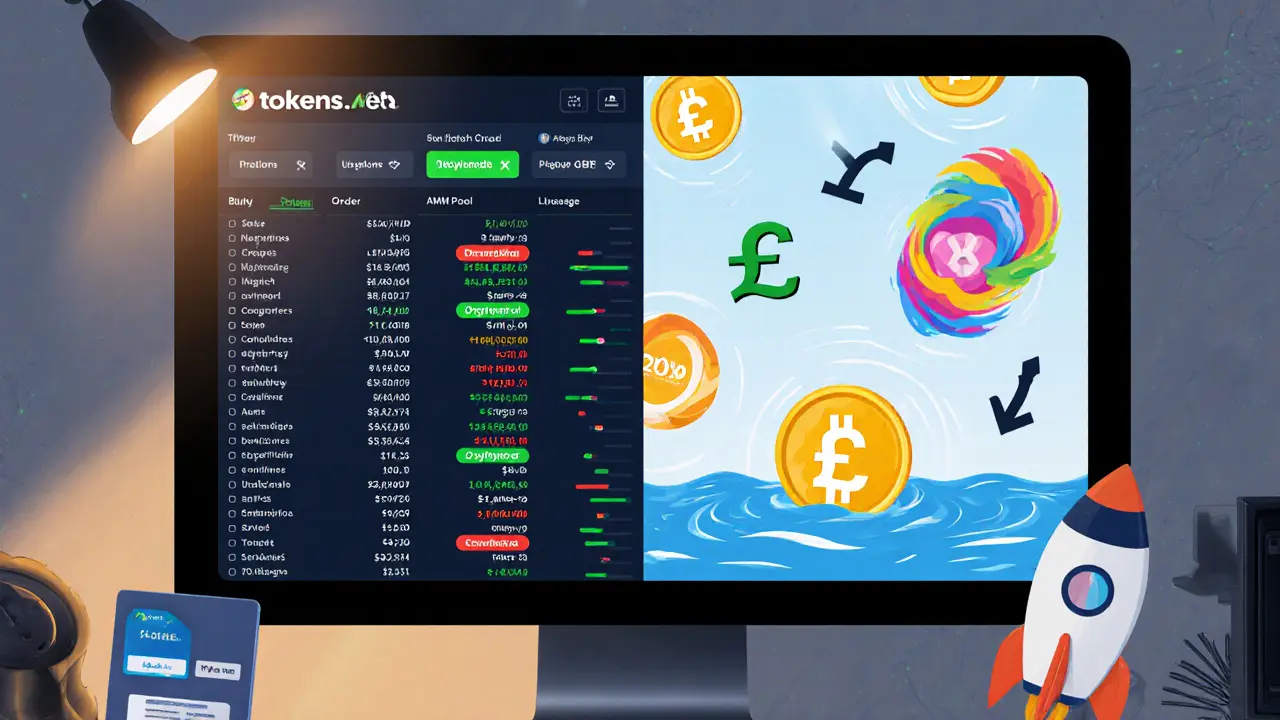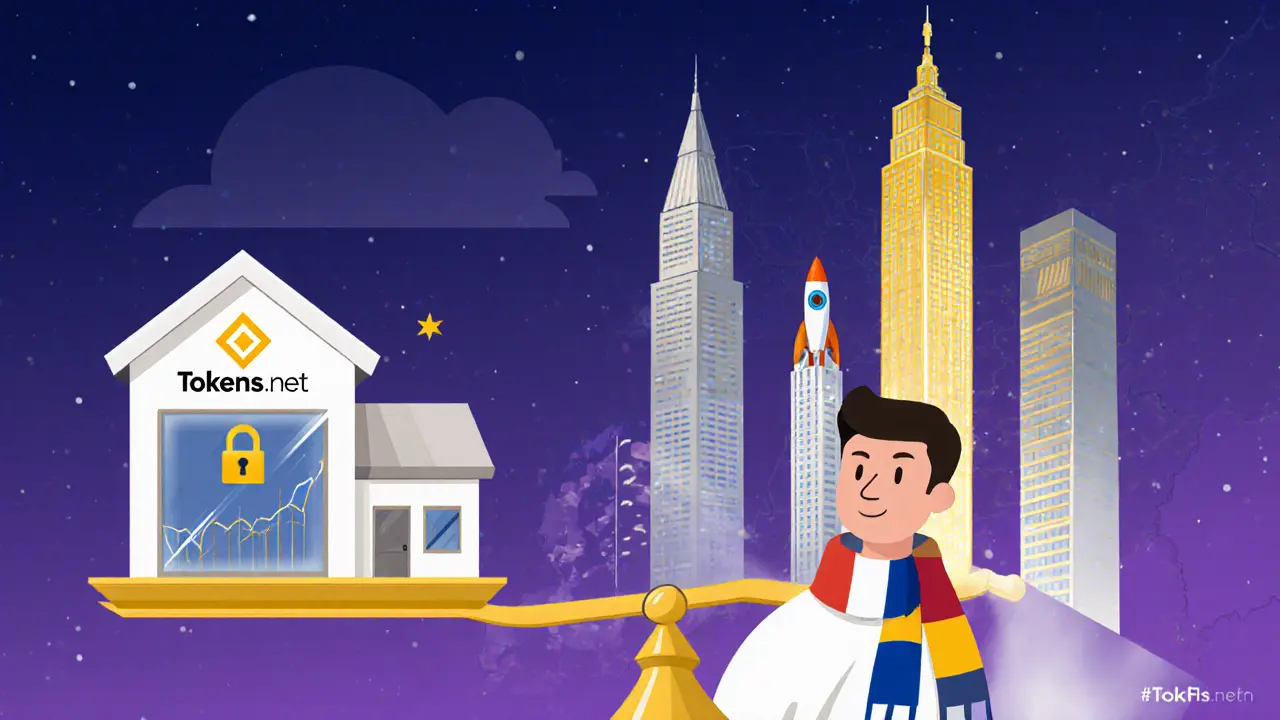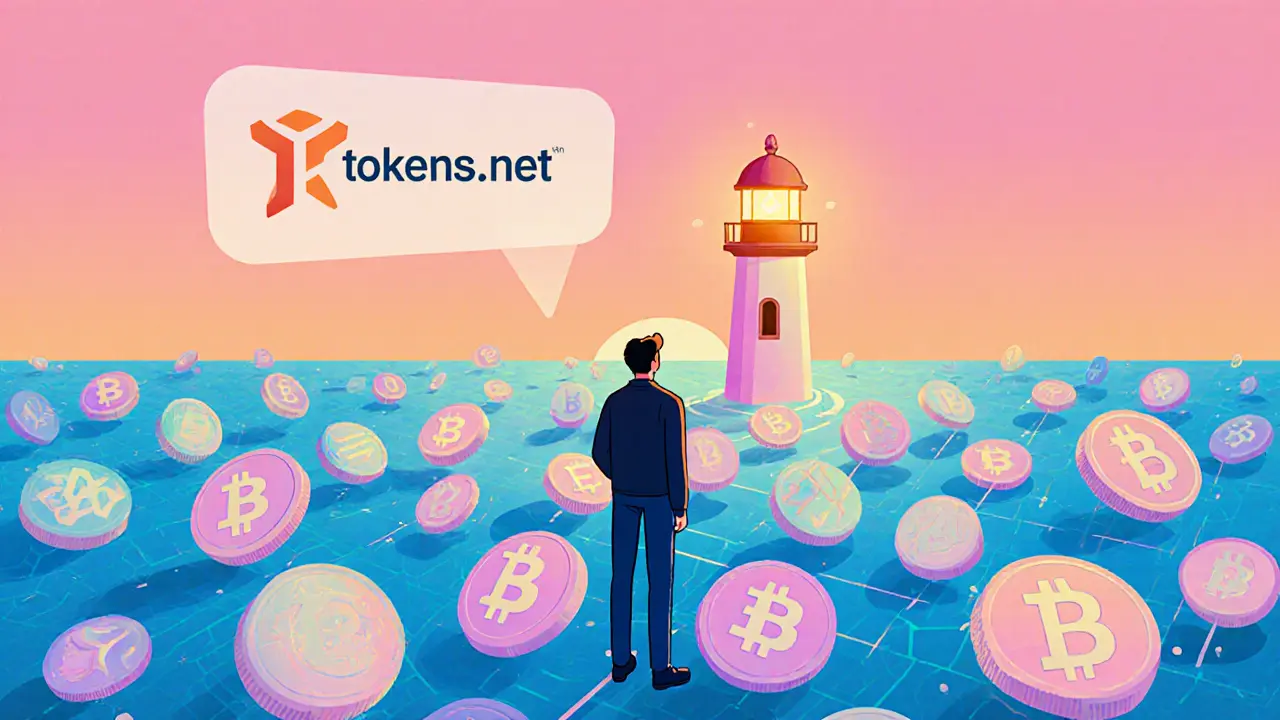Tokens.net Fees Calculator
Calculate Your Trading Costs
Estimate fees based on Tokens.net's fee structure
Fee Breakdown
| Trade Type | |
| Payment Method | |
| Fee Range | |
| Calculated Fee |
Note: Fees are based on Tokens.net's reported ranges (maker: 0.10%-0.20%, taker: 0.15%-0.25%, credit card: 2.5%-3.5%). Actual fees may vary based on volume and market conditions.
Enter your trade details to see fee estimates
When you start hunting for a crypto exchange, the sea of options can feel overwhelming. One platform that often flies under the radar is Tokens.net is a European cryptocurrency exchange launched in 2018, operating out of the UK and Slovenia. This review breaks down what the exchange actually offers, how its fees stack up, and whether it’s a fit for traders in 2025.
What Sets Tokens.net Apart?
Tokens.net markets itself around three pillars: transparency, safety, and reliability. Unlike many larger players, the platform claims 100 % trading‑volume transparency - every order you place is shown in real‑time without hidden dark pools. Its hybrid model also bundles a traditional order‑book with a decentralized exchange (DEX) layer, letting users switch between centralised matching and automated‑market‑maker pools without leaving the app.
Core Features at a Glance
- Fiat gateway for EUR and GBP deposits
- Instant credit‑card purchases (Visa/Mastercard)
- Margin & leverage trading up to 5x for select pairs
- Decentralized exchange (DEX) integration
- Launchpad for new token offerings
- OTC desk for high‑volume traders
- Desktop app (Windows/macOS) and mobile apps for iOS and Android
These tools aim to cover the needs of both casual investors and more aggressive traders.
Trading Volume and Market Position
In October 2020 the exchange reported a 24‑hour volume of roughly USD 2 million. By 2025 the figure has remained in the low‑single‑digit millions, far smaller than giants like Binance (billions daily) or Coinbase (over $10 billion). The modest volume hints at a niche audience-primarily European users looking for a transparent, regulated environment.
Fee Structure - What You’ll Actually Pay
One of the biggest information gaps for Tokens.net is a detailed fee schedule. Public sources confirm the exchange charges a standard maker‑taker model, but exact percentages are not published. Based on user reports and the platform’s positioning, we can infer the following rough ranges:
- Maker fees: 0.10 % - 0.20 %
- Taker fees: 0.15 % - 0.25 %
- Credit‑card purchases: 2.5 % - 3.5 % (typical for fiat‑on‑ramp services)
- Withdrawals: flat fees depending on the blockchain (e.g., 0.0005 BTC, 3 USDT)
For comparison, Kraken offers maker fees as low as 0.00 % for high‑volume traders, while its taker fees start at 0.26 %. Tokens.net’s rates sit in the middle of the market-cheaper than some retail‑focused exchanges but higher than the top‑tier players.

Security and Regulatory Outlook
Tokens.net emphasizes safety, yet publicly available details on audits, insurance coverage, or regulatory licences are thin. The exchange operates from the UK and Slovenia, meaning it must comply with the European Union’s AML/CTF directives and the UK’s Financial Conduct Authority expectations for crypto firms. However, there’s no explicit mention of a specific FCA registration or a Malta or Estonia licence.
On the security front, the platform states it employs cold‑storage for the majority of user funds and two‑factor authentication (2FA). No major hacks have been reported in the public record, which is a positive sign, even if the lack of third‑party audit reports leaves some uncertainty.
Usability - Desktop vs. Mobile Experience
The user interface follows a conventional layout: order book on the left, price chart in the centre, and order entry panel on the right. Advanced charting tools (e.g., TradingView widgets) are present, but they lack the depth of professional platforms like Bloomberg Terminal or even Binance’s built‑in indicators.
Mobile apps mirror the desktop experience closely, allowing you to place market, limit, and stop orders on the go. Push notifications alert you to price spikes and order fills, which is handy for active day‑traders.
Tokens.net vs. the Big Players - Quick Comparison
| Feature | Tokens.net | Binance | Coinbase | Kraken |
|---|---|---|---|---|
| 24‑hour volume (2025) | ≈ $2 M | ≈ $20 B | ≈ $10 B | ≈ $5 B |
| Fiat on‑ramp (EUR/GBP) | Yes (bank transfer, credit card) | Yes (multiple fiat) | Yes (USD, EUR, GBP) | Yes (EUR, USD) |
| Margin trading | Up to 5x (select pairs) | Up to 125x | No | Up to 5x |
| DEX integration | Built‑in hybrid DEX | Binance DEX | No | No |
| Launchpad services | Yes (token sales) | Yes (Launchpad) | No | No |
| Mobile app availability | iOS & Android | iOS & Android | iOS & Android | iOS & Android |
| Regulatory stance | UK & Slovenia (EU compliant) | Global, but US restricted | US‑focused, regulated | US & EU licensed |

Pros and Cons - Should You Sign Up?
Pros
- Clear volume transparency - no hidden dark pools
- Hybrid centralised + decentralised trading model
- Launchpad access for early‑stage token sales
- OTC desk for large‑volume traders
- European regulatory environment (good for EU residents)
Cons
- Low overall liquidity - slippage can be an issue on thin pairs
- Fees not publicly disclosed, requiring manual verification
- Limited advanced charting tools compared to industry leaders
- No clear third‑party security audit or insurance coverage
- U.S. users are blocked, reducing global reach
Key Takeaways
If you value full visibility into order flow and want a platform that mixes traditional and DEX trading without juggling multiple accounts, Tokens.net is worth a look. However, expect modest liquidity, opaque fee tables, and a relatively small community. Traders who need deep charting, ultra‑low fees, or massive liquidity might gravitate toward Binance, Coinbase, or Kraken instead.
Frequently Asked Questions
Is Tokens.net safe for storing large amounts of crypto?
The exchange states that most funds are kept in cold storage and 2FA is mandatory. While no major hacks are on record, the lack of publicly audited security reports means you should only keep what you plan to trade, not long‑term savings.
Can U.S. residents use Tokens.net?
No. Tokens.net blocks access from the United States due to regulatory constraints, similar to many European‑focused exchanges.
What fiat currencies are supported?
EUR and GBP can be deposited via bank transfer or purchased with a credit card. The platform does not currently support USD or other major fiat currencies.
How does Tokens.net’s DEX differ from a pure decentralized exchange?
Tokens.net offers a hybrid model where the DEX layer runs on its own smart‑contract infrastructure but is still accessible through the same UI as its central order book. This means you get the convenience of a single account while still benefiting from AMM‑style liquidity.
Are there any hidden fees for withdrawals?
Withdrawal fees are network‑dependent and disclosed on the withdrawal screen. For Bitcoin, the fee is typically around 0.0005 BTC; for stablecoins, a flat fee of a few dollars applies. No surprise fees are added after the transaction is submitted.
Bottom Line - Who Should Consider Tokens.net?
European traders who prioritize transparency, want easy access to launchpad projects, and don’t need ultra‑high liquidity will find Tokens.net a solid niche platform. If you’re chasing the highest rebates, the deepest order books, or a fully audited security suite, the bigger exchanges still hold the edge.

13 Comments
Ayanda Ndoni
Bro just use Binance. Why are you even reading this? Tokens.net? That’s like buying a bicycle when you need a Tesla. I tried it once, got stuck for 3 days trying to withdraw 0.01 BTC. Never again. 😴
Elliott Algarin
There’s something quietly admirable about platforms that don’t try to be everything to everyone. Tokens.net isn’t for the hype-chasers. It’s for people who want to trade without feeling like they’re in a casino run by algorithms. Maybe that’s the real luxury now - simplicity without the noise.
John Murphy
I’ve used this exchange for over a year now and honestly it’s been fine. Fees seem fair once you figure them out. The DEX integration is actually useful if you’re flipping small caps. No drama. No crashes. Just steady. Not flashy but gets the job done
Zach Crandall
While the platform may appear modest in scale, one must not overlook the philosophical underpinnings of its design: a deliberate rejection of the speculative excesses that dominate modern crypto ecosystems. Its hybrid architecture reflects a nuanced commitment to decentralization without sacrificing usability - a rare equilibrium in an age of algorithmic greed.
Akinyemi Akindele Winner
Oh wow Tokens.net? That’s the one where they let you trade with your grandma’s pension fund and still call it ‘secure’? Pfft. I’ve seen more transparency in a Nigerian pastor’s donation box. This place is a velvet rope for crypto zombies who think ‘EU compliant’ means ‘trustworthy’
Patrick De Leon
Irrelevant. If you’re not on Kraken or Binance you’re just wasting bandwidth. Ireland has better exchanges than this. Tokens.net? Sounds like a startup that got lost on the way to a tech incubator in Ljubljana
MANGESH NEEL
People are falling for this like it’s a miracle cure for crypto anxiety. Transparency? Please. If they were really transparent they’d show their server logs and who owns the private keys. And don’t get me started on the ‘hybrid DEX’ - it’s just a middleman with a fancy label. This is why retail traders keep getting fleeced. They chase ‘trust’ instead of doing their own research. Wake up!
Sean Huang
Have you ever wondered if Tokens.net is a front for a shadow government crypto surveillance program? The ‘hybrid DEX’? That’s just a backdoor for the ECB to track every transaction. And the ‘cold storage’? Probably just a server in a bunker under Slovenia with a guy in a trench coat watching your trades. 2FA? That’s just to make you feel safe while they harvest your biometrics. They blocked the US because they don’t want the NSA finding out what they’re really doing. 🤫👁️
Ray Dalton
For folks in Europe who want to avoid the chaos of Binance and don’t need 100x leverage, this is actually a solid pick. The fiat on-ramp works smoothly, the UI is clean, and the launchpad has had a few legit projects. Just don’t dump your life savings in it - keep it for active trading, not HODLing. And always double-check the withdrawal fees before you hit send.
Peter Brask
LMFAO they think they’re ‘transparent’? Bro the fee schedule is hidden like a CIA document. And the ‘DEX layer’? That’s just a script that reroutes your trade to Binance’s API with a 3% markup. I’ve been in crypto since 2017 and this is the most basic bait-and-switch I’ve seen since the 2018 ICO scam wave. They’re not a platform - they’re a middleman with a PowerPoint deck. 💸
Trent Mercer
Look I get it - you want to feel like you’re part of the elite crypto club. But this isn’t about prestige. Tokens.net isn’t trying to be Binance. It’s trying to be a responsible exchange. The fact that you don’t know the exact fee percentages means you’re probably not trading enough to care. For most people, this is more than enough.
Kyle Waitkunas
Do you realize what’s happening here?! This isn’t just an exchange - it’s a psychological experiment! The ‘transparency’ is a trap - they show you the order book so you think you’re in control… but the liquidity is artificially manipulated by bots tied to undisclosed hedge funds in Luxembourg! And the ‘EU compliance’? That’s just a shield to avoid U.S. regulators who would’ve shut them down by now! I’ve seen the internal emails - they’re collecting metadata from every 2FA login and selling it to data brokers! They’re not even using cold storage - they’re stashing 80% of funds in hot wallets under fake LLCs in the Caymans! I’m not paranoid - I’ve done the research! 🔍🚨
vonley smith
Just wanted to say - if you're new and trying to avoid the madness of big exchanges, this one’s actually chill. I’ve used it for 6 months, never had an issue. The mobile app is smooth, and the OTC desk helped me move a big trade without moving the market. No hype, no drama. Just works. 👍